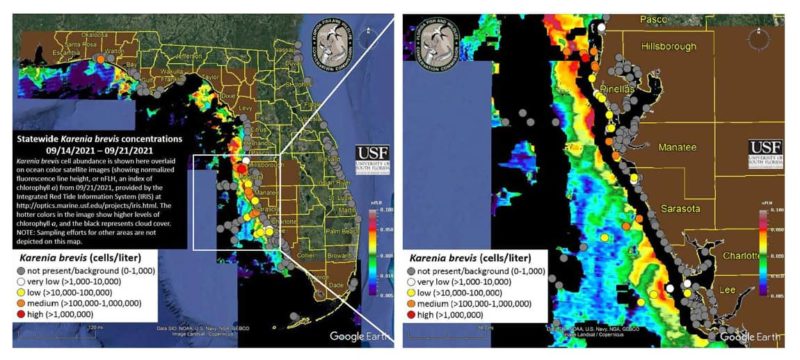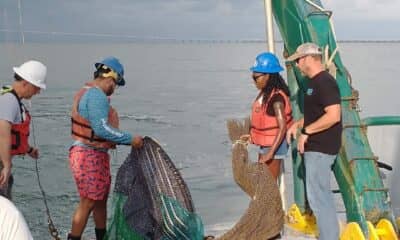Thrive
Not so fast: Red tide regains strength off Pinellas coast

After two weeks of slow dissipation along the Pinellas County coast, Karenia brevis – the harmful algal bloom that causes red tide – appears to be regaining strength.
According to the Florida Fish and Wildlife Commission’s (FWC) latest sampling, a low concentration of K.brevis persists from the southern tip of Pinellas north to Indian Rocks Beach. However, the highest levels were recorded on the northern end of the Pinellas County coast. Medium concentrations start around Sand Key, with one sample lingering outside of Clearwater Harbor.
The FWC also recorded medium concentrations around Clearwater Beach, and high concentrations are present offshore of Caladesi and Honeymoon Islands. Altogether, the FWC observed bloom levels of K. brevis in seven samples taken around Pinellas County last week. J.P. Brooker, Director of Florida Conservancy for the Ocean Conservancy, noted that high concentrations persist from Pinellas County as far south as Port Charlotte.
“I see the presence of red tide all up and down the West-Central, Southwest Florida coast, so it’s definitely still there,” said Brooker.
Brooker points to the 2018 red tide event that lasted into 2019 and said it took sustained colder weather to clear red tide from the warm Gulf waters. He adds the state has just passed peak tropical storm season, and while the area got its first taste of a “cold front” today, it will be quite sometime before the tepid gulf water begins to cool significantly.
“What really concerns me is the warm water,” said Brooker. “I think warm water is going to keep red tide lingering, and we’re seeing that. We see it flow out a little bit, and then you look at the map today, and there it is.”
In the last week, the FWC reported three fish kills. One occurred at the Caladesi Island Beach State Park, another at the Bellaire Beach boat ramp, and the latest fish kill was observed on Sept. 20 at Madeira Beach. While the FWC did not list the species of dead fish at Caladesi and Madeira Beach, dead grouper were spotted at the Bellaire boat ramp.
While Brooker said that was most likely a gag grouper, several dead goliath grouper were pushed into Tampa Bay and spotted off the coast of Pinellas during the peak of the current red tide event in July. Even so, the FWC is meeting in early October to discuss reopening goliath grouper for recreational fishing. These large fish, which can reach the size of a refrigerator and weigh 800 pounds, have been protected since 1990 after the species almost went extinct.
The FWC plans to institute a tag system with permits awarded through a lottery while restricting harvesting to juvenile goliaths. Brooker said the thought is that data collected from harvesting the smaller goliaths will help to understand the stock, but in reality, “the smaller goliaths don’t yield the science that we really need.”
“The red tide event has impacted these really big individuals, and to me, the FWC’s plan seems to be coming at exactly the wrong time in terms of red tide and other water quality issues,” said Brooker. “And it doesn’t tackle the issues that we need to tackle.”
Brooker also fears another release from Piney Point – which is a distinct possibility if rains persist – would cause another catastrophic red tide bloom like what that in late June and early July.
As of the latest update on Thursday, Piney Point has received 30.6 inches of rain since the beginning of June and is forecast to receive 1.7 inches more through the last week of September. The current storage capacity for additional rainfall is just 8.8 inches. That capacity is expected to change with rainfall amounts, as well as with adjusted water management procedures onsite.
As part of the site’s water management efforts, piping of wastewater to the North Regional Water Reclamation facility resumed on Sept. 2. To date, over 2 million gallons were transferred offsite. “Spray evaporation” also continues at the site. The NGS-South reservoir currently holds around 274 million gallons of wastewater.
“It wouldn’t take much rain to be in a situation where we’re overlapping the bounds of the reservoir there,” said Brooker. “One big rainfall event is sure to dump some of that Piney Point water back into the bay.”
There is a sliver of good news, as Brooker said he is still optimistic that Tampa Bay will remain clear of red tide unless another tropical storm pushes it back into the bay.
“There is a high concentration just outside of the bay that could get pushed back into the bay from a storm,” he said. “But hopefully, that window is closed.”







